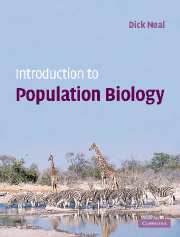Book contents
- Frontmatter
- Contents
- Preface
- Acknowledgements
- PART I Evolution by natural selection
- PART II Simple population growth models and their simulation
- PART III Population genetics and evolution
- PART IV Demography
- PART V Interactions between species, and the behaviour of individuals
- Glossary
- Solutions to problems
- References
- Index
PART I - Evolution by natural selection
- Frontmatter
- Contents
- Preface
- Acknowledgements
- PART I Evolution by natural selection
- PART II Simple population growth models and their simulation
- PART III Population genetics and evolution
- PART IV Demography
- PART V Interactions between species, and the behaviour of individuals
- Glossary
- Solutions to problems
- References
- Index
Summary
Population biology has its roots in many different areas: in taxonomy, in studies of the geographical distribution of organisms, in natural history studies of the habits and interactions between organisms and their environment, in studies of how the characteristics of organisms are inherited from one generation to the next, and in theories which consider how different types of organisms are related by descent. Charles Darwin made a synthesis of these areas in his 1859 book, The Origin of Species by Means of Natural Selection, and this provides us with a convenient starting-point for our introduction to population biology.
The theory of evolution by means of natural selection is the most important theory in biology, but with some notable exceptions one would not realize this after reading many of texts in the area of population biology. Thus, it is no accident that we begin this book with an evolutionary bias.
The purpose of the following three chapters is to provide a historical perspective, and also an understanding of the philosophical content, of Charles Darwin's theory of evolution through the process of natural selection. It is important to understand this Darwinian perspective of biology, because it provides a loose framework for the remainder of this book. In the first chapter we will examine some of the early experiences of Darwin, which may have led him to conclude that organisms evolve and are related by descent.
- Type
- Chapter
- Information
- Introduction to Population Biology , pp. 1 - 2Publisher: Cambridge University PressPrint publication year: 2003



